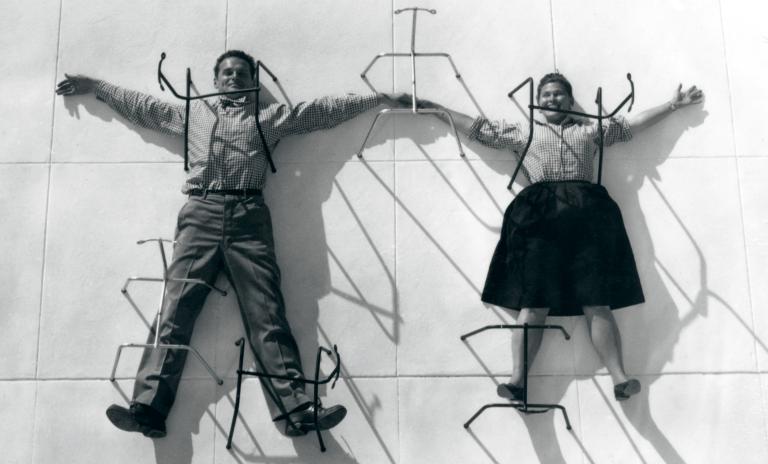The new blueprint for innovation
![{[downloads[language].preview]}](https://www.rolandberger.com/publications/publication_image/ta45_en_cover_download_preview.jpg)
The latest edition of Think:Act prepares us for innovation in 2025 and beyond while faced with constrained resources and uncertainty across the business landscape.
_background_none.png?v=1372397)

by Bennett Voyles
Photos by © Eames Office, LLC. All rights reserved.
The couple's open-minded, light-hearted approach to ideation continues to inspire innovators.
Even today, nearly 50 years after their deaths, Charles and Ray Eames continue to cast a long, sleek shadow on the design world. Indeed, a lot of the best design of our time owes a profound debt to the husband and wife team. And it's not just the famous Eames chair or the familiar sling seating – a ubiquitous feature of airports the world over – resting at the core of their formidable legacy. Top innovators such as Steve Jobs cite the Los Angeles couple as among their biggest influences. Their studio model has also spread their influence beyond the world of design itself. Innovation experts say IDEO, Apple, Pixar and other creativity-focused organizations emulate a number of practices which the Eames Office adopted in the 1940s.
In its prime, the Eameses' playful and collaborative 2,000-square-meter studio featured "exhibition signage, furniture prototypes, desks, vintage toys, a research library, a film screening room, a pet octopus and flexible walls …" according to the Eames Office website. So what’s the recipe for brilliant design, according to the Eameses?

For Charles and Ray Eames, design always began by thinking hard about the client's request. Whether they were thinking about chairs for airports or offices, their work always began by understanding the intended function, a process that Charles described as recognizing the constraints of the problem. "Design depends largely on constraints … the ability of the designer to recognize as many of the constraints as possible; his willingness and enthusiasm for working within those constraints," he once said. This meant that when they innovated, it wasn't for innovation's sake, but because they couldn't meet a need in a conventional way. "Innovate as a last resort," Charles advised.
Being a designer, Charles insisted, was something like being a thoughtful host who tries to anticipate what his guest might want. A good design came down to problem-solving, or as he said another time: "Design is a plan for arranging elements in such a way as best to accomplish a particular purpose." Colleague Bill Lacey agreed. "There is no Eames style," he once said, "only a legacy of problems beautifully and intelligently solved."
What are the boundaries of design? Charles was once asked. "What are the boundaries of problems?" was his reply. But thinking big did not mean being wasteful: Professionals who came of age during the Depression, the Eameses felt strongly about designing products that used low-cost materials and efficient production methods. They aimed to make good design widely available – "the best for the most for the least," as Charles put it – and often delivered: The Eames lounge chair was made from molded plywood using the Kazam! machine, a tool they had also invented. In the fast-growing postwar United States, light, durable and adaptable products made using good, low-cost materials also made the best business sense.
The Eameses were known for their use of photography, model-making and life-size mock-ups to test and then to refine their ideas. Viewing things from different angles was always important to both Charles, who had studied to be an architect, and Ray, who had studied abstract painting. "The thing about a model is that you can play with it; you can test things out in the model that would be laborious, dangerous, or costly – or just plain impossible – to test in 'reality,'" Charles once said. Ray noted that models can also be helpful as communication tools. Ultimately, Charles believed that in certain respects, models constitute the culture of a society. "In the end," he said, "models are what you hand on to the next generation. The 'culture' of a time is the sum of its models."
The Eameses often brought a sense of play into their practice. "Toys are really not as innocent as they look. Toys and games are precursors for serious ideas," Charles once explained. Sometimes, when the circus was in town, the Eameses would send the whole studio out to take pictures. Other times, employees would arrive at work to find the walls had been moved to make room for one of the couple's many side projects. Some of these projects could be quite elaborate: 1957's Toccata for Toy Trains, to name just one, an award-winning 14-minute film made at their home studio, featured a full soundtrack by Elmer Bernstein, a Hollywood composer famous mostly for his work for Alfred Hitchcock. "Take your pleasure seriously," Charles said.

![{[downloads[language].preview]}](https://www.rolandberger.com/publications/publication_image/ta45_en_cover_download_preview.jpg)
The latest edition of Think:Act prepares us for innovation in 2025 and beyond while faced with constrained resources and uncertainty across the business landscape.
